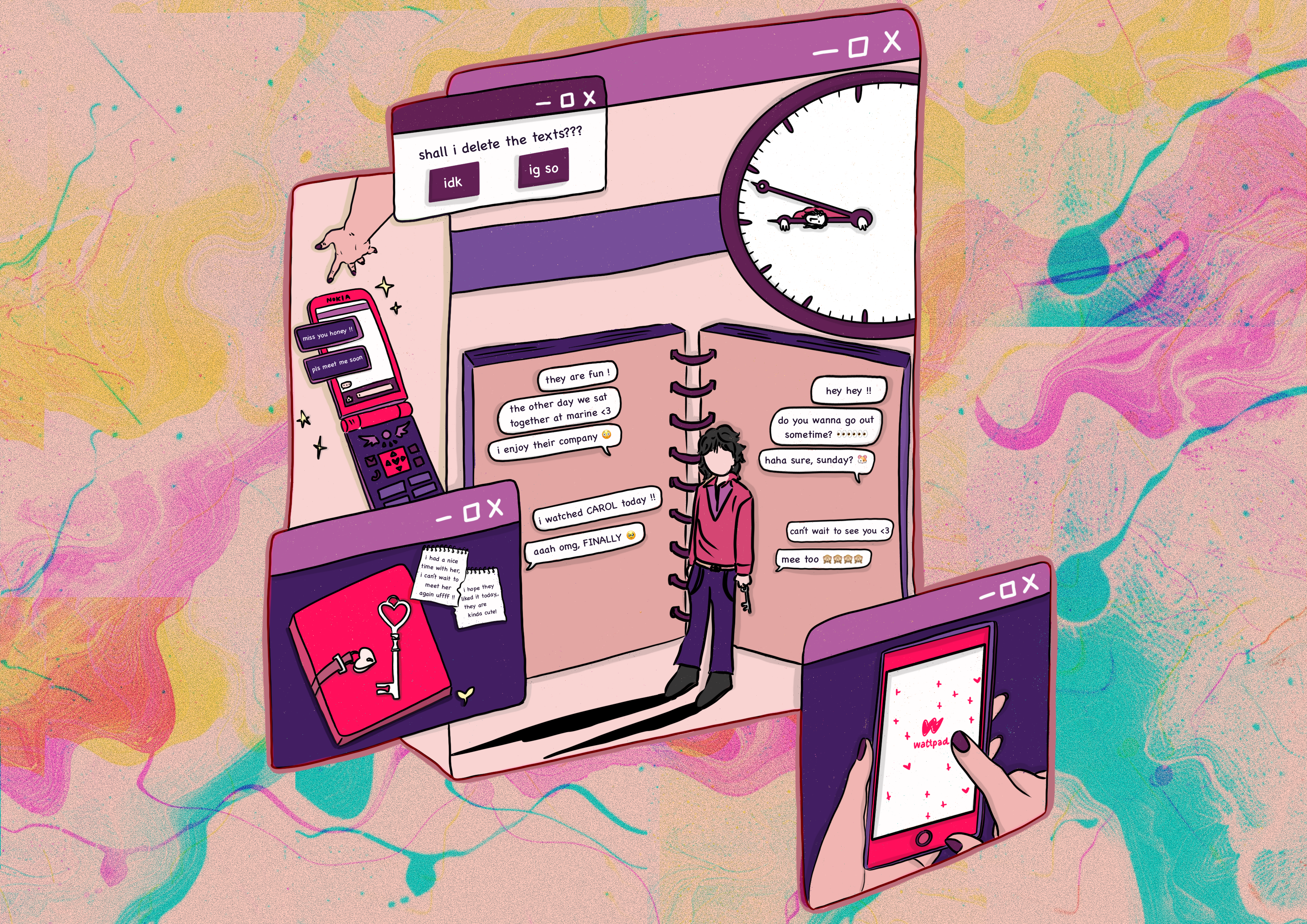
Routine Tech, Intimate Memories: Unwrapping Queer Temporalities through Digital Archives
- Anjani Chadha, Niv and Vanshika Gupta

In a country like India, where surveillance and self-censorship are so pervasive, the virtual realm—specifically chat—becomes an unintended space for building connections. Queer desires are rarely spoken aloud; they are almost always written down. For queer individuals, intimacy unfolds mostly in the digital realm. Queer desires often bloom in the hidden corners of the digital world, where privacy happens to be both a rare present as well as a hard-won necessity. In a landscape where ‘openness’ is a privilege only few are able to seek, these desires are rarely celebrated in daylight; they live in the shadows, whispered through pixels and words, often veiled in secrecy. The chat, thereby, transforms into a place where longing is expressed, explored, and held. It evolves into an intimate archive of desires, a digital record of passing time. Emojis, GIFs, and photographs, often seen as trivial, transcend their typical roles to become tangible symbols of shared moments, functioning as personal records of queer intimacy in the digital age.
In fact, digital spaces do more than serve as shelters for desire; they shape a different experience of time itself. In the context of queerness, time doesn’t always unfold linearly—it resists conventional progression (Halberstam, 2005). The chat thus becomes a site of temporal experimentation, where moments can be revisited, suspended, reimagined, or replayed. Queer lives, often forced to operate outside the normative timelines of family, career, and reproduction, find their own rhythms in these fleeting interactions (Dinshaw et al.).
Amidst this, the screenshot further becomes a time-keeping entity in the never-ending flow of exploration that the chat is. Rather than a mundane capture, it becomes a temporal artefact—an imprint of desire that challenges the linearity of life. It exists outside the “clocked” world, suspended in the perpetual present of digital exchanges. Be it a text exchange laden with innuendo, a heartfelt confession or simply just playful banter, these screenshots, together, become an archive of sorts from within an archive—a careful curation of a way of holding onto something significant in a world that may not always affirm queer desires. In these quiet, transient moments, something powerful happens. A screenshot is taken, a digital pause, a captured fragment of time.
In these intimate fragments, queer individuals not only preserve a moment of connection but also create their own sense of time—one that exists in the gaps and pauses, in the quiet exchange that the world might never see. This digital queer time is not constrained by the expectations of when should desires manifest, but instead it carves out a new timeline—one that resists erasure and demands acknowledgement in its own right.
…
Lately I have been feeling that memories are exhausting. I don’t know why but it feels impossible to hold onto them. Everything slips away too quickly—conversations, emotions, even the little moments I wish I could keep in my pocket forever. It’s as if I’m constantly being pulled forward, surrounded by new stories that my friends tell me, new voices that I hear in this city, new distractions I see around me and hundreds of other things. It’s tiring.
This one night I was sitting with my friends in this bar where I now don’t go often, but sometimes I do. We were chatting, laughing, eating, while some drank too. The table got divided into two parts and I felt I was mixing the two lots of my friends together. As a result, I could hardly pay attention to what the ones sitting on the other end of the table were talking about. One of my friends on the table had just gone through a brutal breakup. It was a matter of group interest all throughout. We often end up discussing the whereabouts of her ex-girlfriend when she would mention something or bring it up. This conversation was pretty similar to what we had heard earlier but this time my friend was saying how hard it was to stop looking at her WhatsApp profile photograph. Every thought of them would take my friend to her chat. A few seconds of stare would follow.
The moment she mentioned this I could see on her face how much it was hurting her, but when everyone at the table started saying, ‘Just delete the texts, block them,’ I felt so out of sync, almost numb. I mean, I get why they were advising that, I too had advised that to some people in the past but this time I couldn’t help but think: those texts aren’t just texts, are they? It might sound cliché and out of date but they’re proof of something real that existed, even if the relationship didn’t last.
I wanted to say something on that table that night though I couldn’t say much. I struggle to put these intense feelings that I have for something, out loud. I am also sure I’m not the only one. Perhaps, that’s why I feel attached more to texts. I often find it difficult to explain my feelings to people who don’t experience things the same way. They seem to have the perfect words to articulate what they feel, while I struggle to express my own emotions. I hold onto old chats too, long after they stop being “useful” in present times. I also feel stuck in the past but still comforted just by the fact that I have those records with me. More than utility, it’s about memory. I don’t want to lose those pieces of myself. More than being confident about sharing these parts of me I feel conflicted as being seen as someone who is being vulnerable and so—the numbness tricks me. I think about all the times I have returned to an old chat, perhaps the numbness is not just a trick but a way of surviving a world that makes little space for these emotions to exist. I feel this holding on, this refusal to let go, is itself a kind of queering. A way of insisting that not everything can be visible to the eyes. Not everything can be expressed. These are very much an archive of queer desires that do not fit the mould of conventional heteronormative structures. That some are not simply meant to be moved on from but carried, held, lived within.
While I was thinking of writing this essay, during one of the conversations with my co-writers, I got reminded of the time when I used to save chats, spoken or textual ones—copy-paste them word for word into my notes app. Not just the good parts, but all of it. Sometimes, the replies that I could not send to friends. The fumbling pauses, the overthought sentences, the things that stung just enough to remind me of the moment I shared that conversation in—almost like dropping hints. It wasn’t about the words but about keeping the pieces of myself I was too scared to express but also the fear of losing those thoughts that keep spiralling in my head. Two of those headers in my notes app are named as “Unsent Texts” and “Lines by people around me.”
Then, one day, they were gone. A glitch, a sync error I guess because I didn’t have space in my phone, the only thing I remember is them not being there on the app. It doesn’t matter how it happened; what matters is that everything I’d saved, everything I thought I could hold onto, vanished. I remember trying everything I could possibly do to bring them all back. I remember trying to tell myself it wasn’t that big of a deal. Some friends said that this is why they write things down in notebooks and not keep them digitally, but I don’t know if that was the point of my loss and if it can be even rationalised and simplified to that.
All I can think of today is that it’s strange, isn’t it? How technology at times becomes this extended part of your body and memory that lets you keep things so close to you; that lets you revisit and reframe a moment in time; but also, how it betrays you sometimes. How fragile it all is after all.
…
When I was 13, I got my first QWERTY keypad phone, a device I was only allowed to use when I was going for my maths tuition. It was also around this time that I experienced having feelings for a woman for the first time. Over the next few years, my life was shaped by both the thrill of young love and the challenges of keeping it a secret. Three years in, by the time I was 16, I had upgraded from the QWERTY phone to a second-hand Samsung Galaxy Tab 2—a modest device that quietly came into my life and changed how I expressed and preserved my identity.
With the QWERTY, secrecy was foremost. Every text— “I miss you,” “Are we meeting tomorrow? I can’t wait to see you”— had to be quickly deleted, hidden from anyone to discover. With no way to save these exchanges, I relied on my pink diary which had a little lock to protect it from ‘intruders’ to document our conversations. This little diary became a silent witness to the most vulnerable moments of my teenage years. I wasn’t just saving chats; I was building a secret world where my queerness could exist uninterrupted. Here, chats weren’t just exchanges of words, they became a medium of queer self-fashioning and self-actualisation, a space where I could articulate and shape parts of myself that had to be suppressed in the offline world. This is where my past, present, and imagined futures converged and became my survival strategy.
Everything changed when the Galaxy Tab 2 entered my life. The white Tab with its red flip cover became my refuge. I would often take screenshots of chats and save them in a hidden folder so that I could keep going back to them on the good, bad and the ugly days. This Tab was a safe haven for my chats, Wattpad stories (a thinly veiled autobiography disguised as fiction), and the digital remnants of my growing understanding of self. I could edit them, archive them or hide them and yet they would exist.
During the years when I was grappling with a sense of not belonging in my all-girls Catholic school; this Tab opened my world beyond the constraints of my physical reality. It was easy to destroy every piece of physical evidence—notes, chits, letters, and photos—but the chats remained, tucked away in a secret folder on my Tab.
It took me seven years to finally come to terms with my queerness and embrace being in what I thought was a romantic relationship at the time. Platforms like Wattpad played a significant role in this journey by giving me a space to write about my queer fantasies under the guise of platonic love or intimate friendships. It allowed me to make sense of my queerness by giving a space where I could talk about it, archive it. All of this when I most needed it. These stories gave me an outlet to articulate my desires, even if the vocabulary was limited and shaped by heteronormative frameworks. Still, they offered me validation—that my feelings weren’t wrong, even if they were illegal at the time.
Queerness isn’t bound by the same timelines that dictate most lives. The seven years it took for me to come to terms with my identity weren’t wasted; they were a queer reworking of time, where self-discovery happened gradually but definitely. Even after all these years, when I revisit those screenshots I don’t see them as fragments of a forgotten past. For me, they are the living artefacts that continue to shape who I am and what I am becoming. The ability to write a ‘secret’ online Wattpad story with homoerotic references or subtle hints of queerness allowed me to eventually understand, or even realise that I was queer. I look back at those Wattpad stories, poems and I am in awe of that 13-year old who found refuge in writing about queerness online, who realised years into writing those stories that they were indeed queer, something about how they looked at love was different than how the conventional popular stories transpired only between heterosexual couples. This queer archiving, unknowingly shaped my queerness, led to understanding it and accepting it eventually.
For me, the online world became a space where I could safely explore my identity without the fear of someone finding my ‘secret’ notebook. It was there, in the vast, intangible expanse of the internet, that I first found the freedom to be queer and to dream.
P.S. The following piece has been written collectively by the three of us, and we have deliberately chosen a fragmented and non-linear storytelling format to reflect together how identity is shaped over time through multiple perspectives. The I’s reflect different people narrating different experiences and bringing them together through this piece.
- Bonner-Thompson, Carl. “Queering Digital Temporalities? Visceral Geographies of Grindr.” Geoforum, vol. 144, 2023.
- Dinshaw, Carolyn, et al. “Theorizing Queer Temporalities: A Roundtable Discussion.” GLQ a Journal of Lesbian and Gay Studies, vol. 13, no. 2, June 2007, pp. 177–95.
- Goltz, Dustin. “Queer Temporalities.” Oxford Research Encyclopedia of Communication. September 15, 2022. Oxford University Press. Date of access 18 Jan. 2025, <https://oxfordre.com/communication/view/10.1093/acrefore/9780190228613.001.0001/acrefore-9780190228613-e-1182>
- Halberstam, Judith. In a Queer Time and Place. New York University Press, 2005, https://doi.org/10.18574/nyu/9780814790892.001.0001.
- “Imagining Queer Futures: Queer Intimate Publics in Digital Space.” My Kali Magazine, 5, Apr 2021.

- Anjani Chadha
Anjani Chadha (she/her) is a freelance journalist and filmmaker currently based in Mumbai.
She is pursuing a Master’s degree in Media and Cultural Studies at Tata Institute of Social
Sciences. Her debut short City of Mirage premiered at the Jio MAMI Mumbai Film Festival in
2023 with further screenings at KASHISH film festival; Bangalore Queer Film Festival, among
others. She has also previously written on art, culture, cinema for publications like The New
Indian Express, Indulge Express, and The Rolling Tape. In 2024, she served as a member of the
pre-screening committee of the 40th IDA Documentary Film Awards.

- Niv
Niv (they/them), a non-binary queer individual, holds a postgraduate degree in Media and
Cultural Studies from TISS, Mumbai. They are a filmmaker and a visual artist currently based in
Mumbai. Their previous work includes four films: On the Right Track (2024), Human Billboards
(2024), City of Mirage (2023) & Grief (Un)locked (2022). They have also worked as a graphic
designer, illustrator and editor with grassroots organisations like Samaj Pragati Sahyog, KhabarLahariya and Bebaak Collective. Their interest lies in gender studies and intersectionality,
primarily because of its far-reaching implications on their personal life and societal
transformation.

- Vanshika Gupta
Vanshika Gupta (they/them) is an independent researcher working at the intersection of
gender, space, informality and digital technologies. With a Master’s degree in Development from
Azim Premji University, Bengaluru, their work is a pursuit of reimagining development as a
living, breathing practice—one that listens, evolves, and includes. Through inquiry and
reflection, they are committed to reshaping frameworks of belonging, care, and justice.

